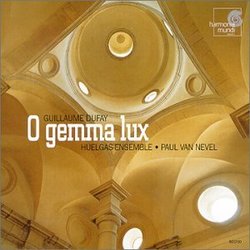| All Artists: Guillaume Dufay, Huelgas Ensemble, Paul van Nevel Title: Dufay: O gemma lux Members Wishing: 2 Total Copies: 0 Label: Harmonia Mundi Fr. Release Date: 6/13/2000 Album Type: Import Genres: Pop, Classical Styles: Vocal Pop, Opera & Classical Vocal, Historical Periods, Early Music Number of Discs: 1 SwapaCD Credits: 1 UPC: 079488150392 |
Search - Guillaume Dufay, Huelgas Ensemble, Paul van Nevel :: Dufay: O gemma lux
 | Guillaume Dufay, Huelgas Ensemble, Paul van Nevel Dufay: O gemma lux Genres: Pop, Classical
Music appreciation textbooks and timelines in magazines often name Guillaume Dufay as the first great composer of the European Renaissance, but one might equally call him the last great composer of the Middle Ages. This d... more » |
Larger Image |
CD Details
Synopsis
Amazon.com
Music appreciation textbooks and timelines in magazines often name Guillaume Dufay as the first great composer of the European Renaissance, but one might equally call him the last great composer of the Middle Ages. This disc presents all 13 of Dufay's isorhythmic motets--the final masterpieces of a very medieval-minded genre. During the Middle Ages, music was considered a science (just like mathematics), and isorhythmic motets are constructed according to strict arithmetical principles. In addition, each voice generally has a different text, while the fundamental voice (called the tenor) usually has no text at all and is often (as here) performed by instruments. As this description might indicate, isorhythmic motets are among the most intellectualized and least emotive works in the entire pre-20th century repertory--yet Paul van Nevel and the Huelgas Ensemble achieve an impressive range of expression from such seemingly poker-faced music. Apostolo glorioso (composed for the consecration of a church) and Ecclesie militantis (written for the coronation of a Pope), performed by choir and (antique) brass, are ornate and imposing, while Magnanime gentes laudes, done by one soprano, one tenor, and one trombone doubled by recorder, is intimate and delicate. The director's excellent program notes explain how isorhythmic motets are constructed and what to listen for. Van Nevel also offers wise advice: Don't listen to this disc straight through--rather, listen carefully to one or two motets several times until you recognize the structural markers, then move on to other motets later. Following that advice will make this CD somewhat more work than most, but the listener's effort will be richly repaid by these splendid performances. --Matthew Westphal

 Track Listings (13) - Disc #1
Track Listings (13) - Disc #1